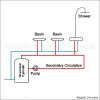As a matter of pure curiosity ....
I somehow got myself onto BES's e-mail list a long time ago, so I frequently get stuff from them. I've noticed recently quite a few adverts for "Secondary Hot Water Circulators". In the pictures, they look like CH circulators/pumps (in fact, most look more like the CH pumps of yesteryear than do modern 'CH circulators'!) but they generally seem appreciably more expensive than CH circulators.
So I'm wondering what exactly these are used for, how they differ from CH circulators and why they are apparently more expensive.
Kind Regards, John
I somehow got myself onto BES's e-mail list a long time ago, so I frequently get stuff from them. I've noticed recently quite a few adverts for "Secondary Hot Water Circulators". In the pictures, they look like CH circulators/pumps (in fact, most look more like the CH pumps of yesteryear than do modern 'CH circulators'!) but they generally seem appreciably more expensive than CH circulators.
So I'm wondering what exactly these are used for, how they differ from CH circulators and why they are apparently more expensive.
Kind Regards, John


